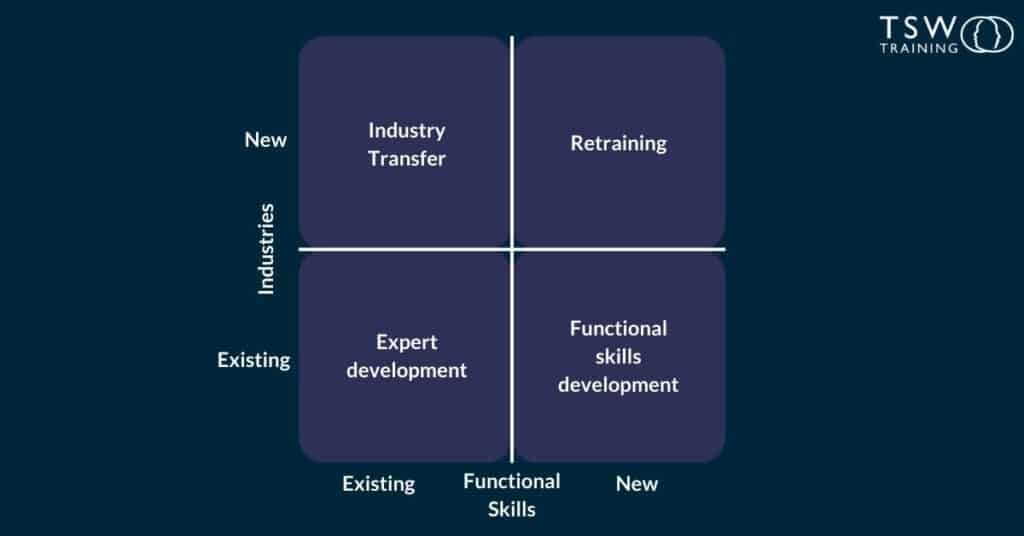The original Ansoff Matrix is a strategic planning tool used by businesses to identify opportunities for growth, while the Personal Ansoff Matrix was adapted from this to focus on personal development instead.
It was developed by Igor Ansoff and first published in the Harvard Businesses Review in 1957.
What is the Personal Ansoff Matrix?
The personal Ansoff Matrix helps you assess the risks of choosing a particular option for your personal development. For example, whether you’re considering learning a new skill or applying for a different role.
There are four possible career move categories:
- Expert development: staying in your current job and enhancing your existing skills
- Functional skills development: learning new skills for a new role in your current organisation
- Industry transfer: using your existing skills for a job in a new industry
- Retraining: having to learn new skills for a new job

Fig. 1. Personal Ansoff Matrix Diagram
Expert development is the lowest risk as you have the security of the same job and are just improving skills you already have.
If you move to functional skills development the risk rises as you’ll have to learn new skills for a new job, but at least you’re in the same industry or organisation. Similarly, industry transfer is equally more of a challenge as you’ll be in a different industry, although you won’t have to learn new skills.
The riskiest category is retraining. This is because you’ll be learning new skills for a completely new job, so you can’t fall back on your current knowledge and experience.
💡Example: Using the Personal Ansoff Matrix to make a decision💡
Liyya works in the partnerships department at her current company and decides to use the Personal Ansoff Matrix to analyse available career options. She’s recently received an email detailing a training program she can join to enhance her existing skills in partner relationship management. She puts this in the expert development category.
A colleague recently asked Liyya if she’d be interested in transferring to the commercial department, which would involve signing up to a different training program to learn new skills. This goes into the functional skills development category. She’s also been headhunted for a partnerships role in another company, but one that works in a different industry, so she tiles this under the industry transfer category.
Knowing it’s a bit of a wildcard, Liyya also puts an option in the retraining category – she’s always had an interest in filming and directing so puts down an opportunity to join a production company which wouldmean a total career change, but it could lead to her dream job.
When using the Matrix, make sure you keep in mind the context of your role and any new role you’re considering.
⏰Key point: For example, for some roles it’s fairly straightforward to move jobs. But for other careers – like something that involves building a client portfolio – it can take years to establish yourself, which can add another element of risk the Matrix can’t account for.
Why is making good decisions important?
Making good decisions is important because, for starters, it can make the best use of available resources, without wasting time and money on inadequate options.
It can also reduce conflict as it can help your team focus on a common goal, rather than bickering over who’s idea was better. This can lead to more effective working and a generally happier, more confident team.
But making bad decisions shouldn’t be a bad thing. After all, it’s possible to turn negatives into positives and good workplaces won’t scorn mistakes – they’ll only ask that you learn from them.
How do you use the Personal Ansoff Matrix?
There are 4 steps involved in using the Personal Ansoff Matrix:
- Step 1 – List: Make a list of all the career options you’re considering
- Step 2 – Plot: Put the options you’re considering in the relevant squares the Matrix grid
- Step 3 – Analyse: Analyse where your options fall on the Matrix grid to determine the level of risk posed by each – you can use SWOT analysis to properly weigh up each option. Don’t forget to include things in your personal life that could be affected by your choice
- Step 4 – Reflect: Consider how you feel about each option – does one in particular jump out at you? Is it worth the associated risk?
💡Example: The Personal Ansoff Matrix in action💡
Liyya has listed out all her career options and plotted them in the Matrix. Now she needs to list the strengths and weaknesses of each, so she decides to use the SWOT analysis. Her notes might look something like the below:
Expert development – stay in current role and undergo training
- Strengths: role is familiar and enjoyable
- Weaknesses: not the most fulfilling option
- Opportunities: chance of a promotion and pay rise
- Threats: processes are becoming automated, meaning less need for relationship management
Functional skills – stay in current organisation but a different role
- Strengths: familiarity with the company and being able to work with friends in that department
- Weaknesses: limited career progression within that department
- Opportunities: opportunity to learn new things and work on different tasks
- Threats: role is more data-led which isn’t a particular strength
Industry transfer – same role in another company and industry
- Strengths: expertise at the role can be transferred and the different industry is exciting
- Weaknesses: would require extensive training to become familiar with new industry
- Opportunities: a great chance to improve network connections
- Threats: new ways of working could affect the future of the role
Retraining – new role, new industry and new company
- Strengths: it’s the most fulfilling option and it offers the most room to develop and grow
- Weaknesses: it’s a much more competitive industry and the pay is lower
- Opportunities: could eventually lead to dream job
- Threats: lack of experience could block opportunities for advancement
⏰Key point: Now Liyya has laid out her analysis, she can sit back and reflect on her options. To help her reach a decision, she could even use this information in discussions with her manager and family – this can be a great way to get various perspectives.
Advantages and disadvantages of the Personal Ansoff Matrix
There are many advantages of the Personal Ansoff Matrix. Three of the main benefits are:
- It’s easy to use: It’s a simple 2×2 grid you sort your options into. It’s also great if you prefer visualisations over written exercises
- The Matrix is helpful for identifying growth opportunities: It allows you to pinpoint where you want your career to go next and what you want to achieve
- It encourages you to step outside your comfort zone: Allows you to weigh up all your options so you can figure out if the risks are worth the rewards
There are also a few disadvantages, including:
- It isn’t universal: It’s only handy for those wanting to develop and grow, so not useful for those who have already achieved their personal goals
- It doesn’t reflect the bigger picture: It’s a self-reflective tool that focuses on your strengths and weaknesses, so doesn’t take into account industry trends or market conditions which may impact your decision. This is why it’s important to use companion tools, like decision trees or other forms of analysis
- It can be time consuming and it doesn’t measure rewards, only risks: You need to put time into listing out your options and plotting them against the Matrix. Not to mention extra the analysis you need to do to figure out what the positives are and whether they outweigh the negatives
What other methods can be used in conjunction with the Personal Ansoff Matrix?
We’ve already mentioned SWOT analysis (sometimes called the TOWS matrix), but there are alternative tools you can use together with the Personal Ansoff Matrix to help you examine your choices. A few examples are:
- Decision trees: A tree-like structure that visually lays out various decisions and likely consequences
- Six Thinking Hats: a decision making method that guides you through different ways of considering something
- Paired comparison analysis: A simple way of directly comparing multiple decisions to find the most suitable outcome
- Decision matrix analysis: Uses a scoring system to work out the best option
- Force Field analysis: Another score-system method to analyse the arguments for and against of something







